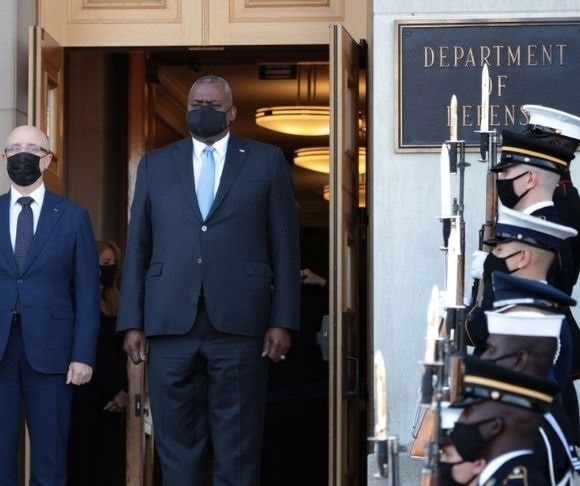Congress has presented the American people a lose-lose dilemma. While the defense appropriations bill is bouncing around the halls of the Capitol, the Biden administration wants to put taxpayers deeper in debt. And the funding bill for national security could be a full-year, stopgap measure called a Continuing Resolution (CR). Moving in that direction, President Joe Biden just signed the CR that kicks the appropriations can down the road to Feb. 18, 2022.
 What is becoming painfully apparent is that liberal legislators have demonstrated a disinterest in defense and a passion for pushing lavish spending of dubious worth that raised the debt ceiling by $2 trillion. Additionally, the drunken sailors on the president’s team are trying to pass a $1.75 trillion social programs and climate package. Keep in mind that attempting to, as The Federalist labeled it, “Build Back Bankrupt” by putting every working American deeper in debt was the plan all along. Biden’s budget request for FY2022, revealed in the Office of Management and Budget figures, anticipated a $1.84 trillion deficit.
What is becoming painfully apparent is that liberal legislators have demonstrated a disinterest in defense and a passion for pushing lavish spending of dubious worth that raised the debt ceiling by $2 trillion. Additionally, the drunken sailors on the president’s team are trying to pass a $1.75 trillion social programs and climate package. Keep in mind that attempting to, as The Federalist labeled it, “Build Back Bankrupt” by putting every working American deeper in debt was the plan all along. Biden’s budget request for FY2022, revealed in the Office of Management and Budget figures, anticipated a $1.84 trillion deficit.
Meanwhile, according to Fox News, though the House of Representatives passed a whopping $770 billion National Defense Authorization Bill, the Senate has yet to act on the legislation. Nonetheless, the real money is in the appropriations law, and defense funding is stuck at the 2021 level. With a CR comes a prohibition on starting new defense programs and an impact on crucial personnel programs. In a United States Naval Institute News (USNI News) story, reporter Mallory Shelbourne quoted the Secretary of Defense Lloyd Austin:
“It would mean that providing the 2.7 percent pay increase the President proposed, and they so richly deserve – as well as housing allowances and other new benefits – would come at the expense of suspending many of their change-of-station moves and force us to limit the numbers of new recruits we bring in.”
The failure to pass an appropriations bill also would affect crucial accounts that fund day-to-day training and other activities. Austin explained, “And it would result in over five billion dollars in cuts to our operating accounts, to hurting the readiness of our troops and our ability to cover the health-care needs of our military families.” The secretary said a full-year CR “would cause enormous, if not irreparable, damage” and would modify “bipartisan priorities.” Unfortunately, Austin’s warning fell on deaf ears since even a nearly half-year CR puts significant pressure on allocating funding for defense programs so that weapon systems and other procurements are not executable.
The potential that Congress could pass a full-year CR is not budget fearmongering. At the recent 2021 Reagan National Defense Forum, the House Armed Services Committee chairman, Representative Adam Smith (D-WA), gave his assessment of the odds of a full-year CR through FY2022. Smith said that the book on an appropriations bill passing in February was a “50-50 call.” He explained, “You cannot start negotiating from the premise of, ‘you have to agree to everything I want, and then we’ll sit down and talk.’” Hold it. “Start negotiating”? What have the appropriations committees been doing for the last year? Apparently nothing. The Democrat-held Congress’ lack of interest in defense is not comforting.
Where the Biden administration stands on defense is no secret, because it sent to Congress a budget request best described as flat. The defense committees in Congress, in contrast, recognized the dangers that China and Russia represent and increased the Pentagon topline from $715 billion, the administration’s ask, to $740 billion. As reported in ExecutiveGov.com, of the total $770 billion in the authorization bill, approximately $30 billion covers national security programs for the Department of Energy but is calculated in the defense funding line.
[memberzone align=”left”] So, this is how the federal budget playing field looks: The defense appropriations real money funding bill will bounce around until a hard stop on Feb. 18, 2022. At that point, our congressional leaders will pass another CR or a defense appropriations bill. Either way, the Pentagon has come up short. Yet, you can bet your bottom dollar, there will be back-slapping and high-fiving all around for avoiding a government shutdown. Never mind that the government would not be in this position if those congratulating themselves had done their jobs back in September.
As reported by Bloomberg, the FY2022 NDAA and the debt-ceiling increase legislation are both on the way to passage the week of Dec. 13. So, national security eked out a win on the authorization — this time.
On the other hand, the American taxpayer lost and is saddled with $2 trillion more debt. As the late Republican senator from Illinois, Everett Dirksen, once reportedly quipped, “A billion here, a billion there, pretty soon it begins to add up to real money.” That was back 1965 when the national debt was $328 billion; we’re talking $30-plus trillion now. How times have changed.
The views expressed are those of the author and not of any other affiliation.
~ Read more from Dave Patterson.




